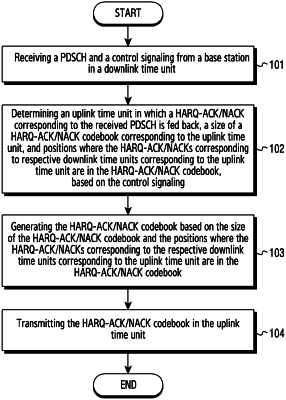| CPC H04L 1/1861 (2013.01) [H04W 72/21 (2023.01)] | 16 Claims |

|
1. A method for transmitting a hybrid automatic repeat request-acknowledgment/negative acknowledgment (HARQ-ACK/NACK) by a user equipment (UE) in a wireless communication system, the method comprising:
identifying a first set including at least one HARQ-ACK/NACK timing value, wherein each timing value in the first set indicates a time difference between a downlink time unit for physical downlink shared channel (PDSCH) reception and an uplink time unit in which a HARQ-ACK/NACK feedback is transmitted;
determining, based on the first set, a second set including at least one downlink time unit for PDSCH reception;
generating a codebook for the HARQ-ACK/NACK feedback based on a size of the codebook, wherein the size of the codebook is identified based on a size of the second set and a number of one or more HARQ-ACK/NACK bits corresponding to each downlink time unit included in the second set; and
transmitting, to a base station, the codebook,
wherein the number of one or more HARQ-ACK/NACK bits is determined based on a maximum number of code block groups (CBGs) in one transmission block (TB), in case that a scheduling for a downlink transmission is based on CBG.
|